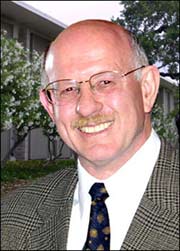
Handy Links
SLAC News Center
SLAC Today
- Subscribe
- Archives: Feb 2006-May 20, 2011
- Archives: May 23, 2011 and later
- Submit Feedback or Story Ideas
- About SLAC Today
SLAC News
Lab News
- Interactions
- Lightsources.org
- ILC NewsLine
- Int'l Science Grid This Week
- Fermilab Today
- Berkeley Lab News
- @brookhaven TODAY
- DOE Pulse
- CERN Courier
- DESY inForm
- US / LHC
SLAC Links
- Emergency
- Safety
- Policy Repository
- Site Entry Form

- Site Maps
- M & O Review
- Computing Status & Calendar
- SLAC Colloquium
- SLACspeak
- SLACspace
- SLAC Logo
- Café Menu
- Flea Market
- Web E-mail
- Marguerite Shuttle
- Discount Commuter Passes
-
Award Reporting Form
- SPIRES
- SciDoc
- Activity Groups
- Library
Stanford
Around the Bay
Dorfan Today: Wildland Fire Danger

The devastating power of a wildland fire was brought home to each of us recently when 254 homes were lost in Lake Tahoe’s Angora fire. Northern California has emerged from its driest winter in at least 20 years, and the wildland fire danger in and around SLAC will remain at high levels through at least October. The quantity of dry, burnable vegetation in the San Francisco Bay Area is above normal and its dryness is already at levels not normally seen until late August. SLAC’s one-acre grass fire in May, followed by two recent grass fires near the Stanford Dish underline our unusually high vulnerability. This means all of us at SLAC must be particularly vigilant and take every measure to reduce fire risk.
SLAC is taking a number of vegetation management measures this summer. In particular, dry grass has been mowed and dead brush has been removed from around buildings, roadways and property lines.
Although we cannot change the weather or climate, there is one factor that each one of us can directly control—the very careful use of potential ignition sources around dry vegetation and other combustible materials. Common examples of sources for ignition include welding, brazing and sparking activities (all of which are covered at SLAC by a permit system), cigarettes, barbecues, and the use of powered machinery (including vehicles) in and around dry grass. Dry, windy days are particularly hazardous: the wind will carry sparks that can ignite a fire quite a distance from the source and wind, of course, will fan any combustion that does occur.
On the most fire-prone "red flag" days, we will notify employees and visitors by posting special signage at the entry gates, with a warning notice in SLAC Today and through other means. For such days, we are considering imposing restrictions on high risk outdoor activities and will keep you informed as to what is decided.
For the duration of the summer, I ask anyone engaging in activities that may produce flames, heat or sparks around or near dry vegetation to please exercise situational awareness and extreme caution. In particular, if you are planning an outdoor barbecue event, you need to contact the fire marshal (Robert Reek, x4509) or the assistant fire marshal (Ralph Kerwin, x2905) in advance to ensure that the location is appropriate and that fire safety measures have been properly incorporated.
As always, my sincere thanks for your continued dedication to safety, to protecting our precious environment, and to the health and welfare of our SLAC family.
—Jonathan Dorfan, SLAC Today, July 9, 2007